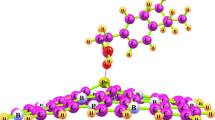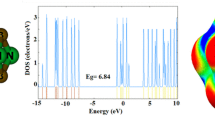Abstract
This study adopted density functional theory (DFT) and analyzed the interaction of the conventional cathinone (CA) drug with perfect and defected monolayer nanosheets of boron carbide (BC3). BC3 was found to have poor interactions with CA. Hence, the perfect nanosheets had poor CA sensitivity. The potential of single and double vacancy (SV and DV) defects in the nanosheet to strengthen the nanosheet-drug interaction were assessed. The energy of adsorption of CA adsorption onto SV-BC3 and DV-BC3 was nearly − 23.78 and − 15.32 kcal/mol, respectively. The adsorption substantially altered the work function and bandgap of the defected nanosheets. However, the perfect BC3 experienced a change merely in bandgap during the drug adsorption—the work function change was slight. Thus, the defected nanosheets could be Φ-type and electronic sensors of CA, whereas the perfect nanosheet has the potential to be solely an electronic detector of CA. A larger dielectric constant led to a significant change in the adsorption energy. Furthermore, DV-BC3 considerably changed in magnetic characteristics due to the drug adsorption.





Similar content being viewed by others
Availability of data and material
N/A.
Code availability
N/A.
References
Gunawan W, Rudiansyah M, Sultan MQ, Ansari MJ, Izzat SE, Al Jaber MS, Aravindhan S (2022) Effect of tomato consumption on inflammatory markers in health and disease status: A systematic review and meta-analysis of clinical trials. Clinical Nutrition ESPEN. https://doi.org/10.1016/j.clnesp.2022.04.019
Khoee S, Sadeghi A (2019) An NIR-triggered drug release and highly efficient photodynamic therapy from PCL/PNIPAm/porphyrin modified graphene oxide nanoparticles with the Janus morphology. RSC Advances 9(68):39780–39792. https://doi.org/10.1039/C9RA06058H
Wu HS, Jiao H (2004) What is the most stable B24N24 fullerene? Chem Phys Lett 386(4–6):369–372
Oku T, Narita I, Nishiwaki A (2004) Formation and structures of B36N36 and Y@ B36N36 nanocages studied by high-resolution electron microscopy and mass spectrometry. J Phys Chem Solids 65(2–3):369–372
Pourbavarsad MS, Jalalieh BJ, Landes N, Jackson WA (2022) Impact of free ammonia and free nitrous acid on nitritation in membrane aerated bioreactors fed with high strength nitrogen urine dominated wastewater. J Environ Chem Eng 10(1):107001. https://doi.org/10.1016/j.jece.2021.107001
Zou Q, Xing P, Wei L, Liu B (2019) Gene2vec: gene subsequence embedding for prediction of mammalian N 6-methyladenosine sites from mRNA. RNA (Cambridge) 25(2):205–218. https://doi.org/10.1261/rna.069112.118
Yang W, Liu W, Li X, Yan J, He W (2022) Turning chiral peptides into a racemic supraparticle to induce the self-degradation of MDM2. J Adv Res. https://doi.org/10.1016/j.jare.2022.05.009
Zhuo Z, Wan Y, Guan D, Ni S, Wang L, Zhang Z, …, Zhang BT (2020) A Loop‐Based and AGO‐Incorporated Virtual Screening Model Targeting AGO‐Mediated miRNA–mRNA Interactions for Drug Discovery to Rescue Bone Phenotype in Genetically Modified Mice. Adv Sci 7(13):1903451.https://doi.org/10.1002/advs.201903451
Li H, Wang F (2021) Core-shell chitosan microsphere with antimicrobial and vascularized functions for promoting skin wound healing. Mater Des 204:109683. https://doi.org/10.1016/j.matdes.2021.109683
Chen L, Huang Y, Yu X, Lu J, Jia W, Song J, …, Li M (2021) Corynoxine protects dopaminergic neurons through inducing autophagy and diminishing neuroinflammation in rotenone-induced animal models of Parkinson’s disease. Front Pharmacol 12:642900. https://doi.org/10.3389/fphar.2021.642900
Yang W, Zhang H, Liu Y, Tang C, Xu X, …, Liu J (2022) Rh (iii)-catalyzed synthesis of dibenzo [b,d]pyran-6-ones from aryl ketone O-acetyl oximes and quinones via C–H activation and C–C bond cleavage. RSC Adv 12(23):14435-14438. https://doi.org/10.1039/D2RA02074B
Obireddy SR, Lai W (2021) Preparation and characterization of 2-hydroxyethyl starch microparticles for co-delivery of multiple bioactive agents. Drug Deliv 28(1):1562–1568. https://doi.org/10.1080/10717544.2021.1955043
Lai W (2020) Non-conjugated polymers with intrinsic luminescence for drug delivery. J Drug Deliv Sci Technol 59:101916. https://doi.org/10.1016/j.jddst.2020.101916
Wang X, Tang S, Chai S, Wang P, Qin J, Pei W, Huang C (2021) Preparing printable bacterial cellulose based gelatin gel to promote in vivo bone regeneration. Carbohydr Polym 270:118342. https://doi.org/10.1016/j.carbpol.2021.118342
Mazaleuskaya LL, Sangkuhl K, Thorn CF, FitzGerald GA, Altman RB, Klein TE (2015) PharmGKB summary: pathways of acetaminophen metabolism at the therapeutic versus toxic doses. Pharmacogenet Genomics 25:416
Dong H, Zheng L, Yu P, Jiang Q, Wu Y, Huang C, Yin B (2019) Characterization and application of lignin–carbohydrate complexes from lignocellulosic materials as antioxidants for scavenging in vitro and in vivo reactive oxygen species. ACS Sustain Chem Eng 8(1):256–266. https://doi.org/10.1021/acssuschemeng.9b05290
Ravisankar S, Vasudevan M, Gandhimathi M, Suresh B (1998) Reversed-phase HPLC method for the estimation of acetaminophen, ibuprofen and chlorzoxazone in formulations. Talanta 46:1577–1581
Trettin A, Zoerner AA, Böhmer A, Gutzki F-M, Stichtenoth DO, Jordan J et al (2011) Quantification of acetaminophen (paracetamol) in human plasma and urine by stable isotope-dilution GC–MS and GC–MS/MS as pentafluorobenzyl ether derivative. J Chromatogr B 879:2274–2280
Burgot G, Auffret F, Burgot J-L (1997) Determination of acetaminophen by thermometric titrimetry. Anal Chim Acta 343:125–128
Ruengsitagoon W, Liawruangrath S, Townshend A (2006) Flow injection chemiluminescence determination of paracetamol. Talanta 69:976–983
Huang C, Su Y, Shi J, Yuan C, Zhai S, Yong Q (2019) Revealing the effects of centuries of ageing on the chemical structural features of lignin in archaeological fir woods. New J Chem 43(8):3520–3528. https://doi.org/10.1039/C9NJ00026G
Lee C, Yan H, Brus LE, Heinz TF, Hone J, Ryu S (2010) Anomalous lattice vibrations of single-and few-layer MoS2. ACS Nano 4:2695–2700
Hoshino A, Fujioka K, Oku T, Suga M, Sasaki YF, Ohta T et al (2004) Physicochemical properties and cellular toxicity of nanocrystal quantum dots depend on their surface modification. Nano Lett 4:2163–2169
Huang C, Tang S, Zhang W, Tao Y, Lai C, Li X, Yong Q (2018) Unveiling the structural properties of lignin–carbohydrate complexes in bamboo residues and its functionality as antioxidants and immunostimulants. ACS Sustain Chem Eng 6(9):12522–12531. https://doi.org/10.1021/acssuschemeng.8b03262
Khoee S, Sadeghi A (2019) An NIR-triggered drug release and highly efficient photodynamic therapy from PCL/PNIPAm/porphyrin modified graphene oxide nanoparticles with the Janus morphology. RSC Adv 9(68):39780–39792. https://doi.org/10.1039/C9RA06058H
Niknam B, Aboutalebi FH, Ma W, Nejad RM (2021) Effect of variations internal pressure on cracking radiant coils distortion. In Structures, vol 34. Elsevier, pp 4986–4998. https://doi.org/10.1016/j.istruc.2021.10.083
Ma W (2021) Behavior of aged reinforced concrete columns under high sustained concentric and eccentric loads. Doctoral dissertation, University of Nevada, Las Vegas
Jiang J, Zhang T, Chen D (2021) Analysis, design, and implementation of a differential power processing DMPPT with multiple buck–boost choppers for photovoltaic module. IEEE Trans Power Electron 36(9):10214–10223. https://doi.org/10.1109/TPEL.2021.3063230
Jasim SA, Hadi JM, Opulencia MJC, Karim YS, Mahdi AB, Kadhim MM ... Falih KT (2022) MXene/metal and polymer nanocomposites: preparation, properties, and applications. J Alloys Compd 165404. https://doi.org/10.1016/j.jallcom.2022.165404
Li X, Shang Z, Peng F, Li L, Zhao Y, Liu Z (2021) Increment-oriented online power distribution strategy for multi-stack proton exchange membrane fuel cell systems aimed at collaborative performance enhancement. J Power Sources 512:230512. https://doi.org/10.1016/j.jpowsour.2021.230512
Guo H, Zhang Y (2020) Resting state fMRI and improved deep learning algorithm for earlier detection of Alzheimer’s disease. IEEE Access 8:115383–115392. https://doi.org/10.1109/ACCESS.2020.3003424
Liu R, Hu Y, Xu J, Cai A, Wu A, Chen L, …, Wang F (2021) Circulating circRNAs as Potential Biomarkers for Cancers. Oncologie 23(3). https://doi.org/10.32604/oncologie.2021.018514
Nardelli MB, Yakobson BI, Bernholc J (1998) Mechanism of strain release in carbon nanotubes. Phys Rev B 57:R4277
Stone AJ, Wales DJ (1986) Theoretical studies of icosahedral C60 and some related species. Chem Phys Lett 128:501–503
Pan B, Yang W, Yang J (2000) Formation energies of topological defects in carbon nanotubes. Phys Rev B 62:12652
Orellana W, Fuentealba P (2006) Structural, electronic and magnetic properties of vacancies in single-walled carbon nanotubes. Surf Sci 600:4305–4309
Rossato J, Baierle R, Orellana W (2007) Stability and electronic properties of vacancies and antisites in B C 2 N nanotubes. Phys Rev B 75:235401
Berber S, Oshiyama A (2006) Reconstruction of mono-vacancies in carbon nanotubes: atomic relaxation vs. spin polarization. Phys B Condens Matter 376:272–5
Li Y, Zhou Z, Golberg D, Bando Y, Schleyer PvR, Chen Z (2008) Stone− wales defects in single-walled boron nitride nanotubes: formation energies, electronic structures, and reactivity. J Phys Chem C 112:1365–70
Sivaraman R, Patra I, Opulencia MJC, Sagban R, Sharma H, Jalil AT, Ebadi AG (2022) Evaluating the potential of graphene-like boron nitride as a promising cathode for Mg-ion batteries. J Electroanal Chem 116413. https://doi.org/10.1016/j.jelechem.2022.116413
Schmidt MW, Baldridge KK, Boatz JA, Elbert ST, Gordon MS, Jensen JH et al (1993) General atomic and molecular electronic structure system. J Comput Chem 14:1347–1363
Schleyer PvR, Maerker C, Dransfeld A, Jiao H, van Eikema Hommes NJ (1996) Nucleus-independent chemical shifts: a simple and efficient aromaticity probe. J Am Chem Soc 118:6317–8
Chupradit S, Nasution MK, Rahman HS, Suksatan W, Jalil AT, Abdelbasset W ... Bidares R (2022) Various types of electrochemical biosensors for leukemia detection and therapeutic approaches. Anal Biochem 114736. https://doi.org/10.1016/j.ab.2022.114736
Behmagham F, Vessally E, Massoumi B, Hosseinian A, Edjlali L (2016) A computational study on the SO2 adsorption by the pristine, Al, and Si doped BN nanosheets. Superlattice Microst 100:350–357
Author information
Authors and Affiliations
Contributions
Huifang Liu: original draft, writing-review and editing, writing-software, methodology.
KeWei Wang: conceptualization, investigation, project administration, supervision.
Corresponding author
Ethics declarations
Competing interests
The authors declare no competing interests.
Additional information
Publisher's note
Springer Nature remains neutral with regard to jurisdictional claims in published maps and institutional affiliations.
Rights and permissions
Springer Nature or its licensor holds exclusive rights to this article under a publishing agreement with the author(s) or other rightsholder(s); author self-archiving of the accepted manuscript version of this article is solely governed by the terms of such publishing agreement and applicable law.
About this article
Cite this article
Liu, H., Wang, K. Utilization of boron carbide nanosheet in the recognition cathinone drug concentration in the human body. J Mol Model 28, 262 (2022). https://doi.org/10.1007/s00894-022-05268-8
Received:
Accepted:
Published:
DOI: https://doi.org/10.1007/s00894-022-05268-8




